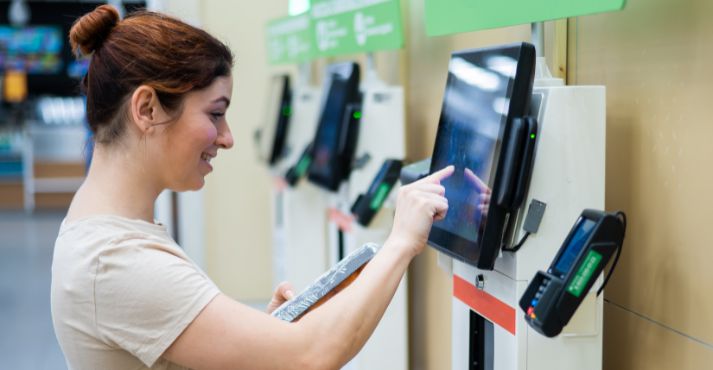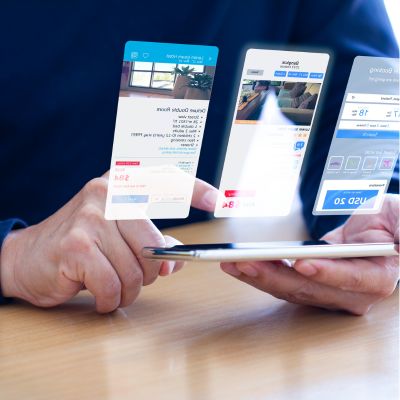Let’s dive into the evolution of the hospitality industry with the advent of self-check-in, a game-changer that has reshaped how guests experience arrival.
In this era of technological advancements, the concept of self-check-in is a testament to increased autonomy and convenience for guests.
We’ll explore how this innovation has transformed the traditional check-in process, providing a seamless and efficient experience in hospitality.
What is Self Check-In?

Self-check-in represents a transformative approach to traditional hotel check-in, empowering guests to complete their registration independently.
Evolution of Check-In Processes
The evolution of check-in processes, culminating in the prevalence of self-check-in, reflects technology’s transformative impact on guest expectations and hotel operations.
This paradigm shift signifies a departure from traditional methods toward a more streamlined and technologically advanced approach.
Check-In Evolution: The journey from manual, face-to-face check-ins to self-check-in autonomy represents a significant evolution. Technological advancements have played a pivotal role in reshaping this fundamental aspect of the guest experience.
Technology Impact: Technology integration has expedited check-in processes and elevated the overall guest experience. The convenience of self-check-in aligns with the contemporary traveler’s desire for efficiency and digital engagement.
Guest Expectations: Modern travelers increasingly expect a seamless and tech-savvy check-in experience. The adoption of self-check-in meets these expectations, offering a solution that aligns with the preferences of a generation accustomed to digital convenience.
How Does Self Check-In Work?
Understanding self-check-in mechanics involves a closer look at using digital interfaces and kiosks. These elements are pivotal in streamlining the process providing guests with a user-friendly experience.
Digital Interfaces and Kiosks
Digital Interfaces: Guests engage with digital interfaces accessible through the hotel’s website or dedicated check-in applications. These interfaces serve as the entry point for the self-check-in process, prompting users to input necessary information.
Kiosks: Strategically placed self-service kiosks within the hotel premises guide guests through the check-in steps. These interactive kiosks facilitate a seamless process, allowing guests to independently input details and navigate the registration procedure.
Self-Check-In Steps: The journey typically involves entering personal information, confirming reservation details, selecting room preferences, and providing payment information. Once completed, the system validates the details, ensuring a smooth and error-free check-in process.
Mobile App Integration
In addition to digital interfaces and kiosks, mobile apps are instrumental in the self-check-in landscape. Integrating mobile apps offers features that streamline check-in and enhance the overall guest experience.
Mobile App Integration: Guests can leverage dedicated hotel mobile apps to initiate check-in remotely. These apps provide an intuitive platform for entering information, ensuring a user-friendly and personalized experience.
Mobile Key Access: A standout feature of mobile app integration is providing mobile key access. Guests can use their smartphones as digital room keys, eliminating the need for physical vital cards and enhancing security and convenience.
Pre-Arrival Check-In: Mobile apps often offer pre-arrival check-in options, allowing guests to complete the necessary steps before reaching the hotel. This expedites the process upon arrival, minimizing wait times and optimizing efficiency.
Benefits of Self Check-In
1. Time Efficiency
One of the primary advantages of self-check-in is the substantial time efficiency it offers guests. By opting for self-service solutions, travelers can expedite the check-in process, resulting in reduced wait times and an overall enhancement of their travel experiences.
Time Efficiency: Self-check-in provides quick and efficient solutions for guests, allowing them to complete the check-in process swiftly. This time-saving approach aligns with the modern traveler’s desire for expedited services.
Expedited Check-In: Guests utilizing self-check-in methods experience expedited check-in procedures, minimizing the time spent at the front desk. This efficiency becomes particularly valuable during peak travel periods or busy hotel hours.
Reduced Wait Times: The streamlined nature of self-check-in translates to significantly reduced wait times. Guests can seamlessly navigate the check-in steps, ensuring a prompt and hassle-free arrival experience.
2. Guest Empowerment
Beyond time efficiency, self-check-in empowers guests by offering control and customization over their arrival experiences.
This empowerment is manifested through the freedom to choose arrival times, express room preferences, and tailor the check-in process to individual preferences.
Guest Empowerment: Self-check-in provides a sense of empowerment to travelers. Guests can decide when to initiate the check-in process, aligning with their schedules and preferences.
Arrival Time Flexibility: With self-check-in, guests can choose arrival times that suit their itineraries. This flexibility reduces the stress associated with rigid check-in schedules.
Room Preferences: Empowered by self-check-in options, guests can express their room preferences in advance. Whether it’s a specific floor, bed type, or other accommodations, this customization adds a personalized touch to their stay.
3. Reduced Queues and Contact
Another notable benefit of self-check-in is the reduction of queues and the promotion of contactless processes. This aligns seamlessly with modern preferences for streamlined, efficient, and contactless interactions.
Reduced Queues: Self-check-in significantly contributes to reducing queues at the front desk. The efficient, self-service nature of the process minimizes congestion, especially during peak periods.
Contactless Check-In: Embracing self-check-in aligns with the contemporary trend of contactless hotel interactions. Guests can complete the check-in process without requiring extensive physical contact, enhancing safety and convenience.
Contactless Hospitality Trends: The preference for reduced queues and contactless processes reflects broader trends in modern hospitality. Hotels adopting self-check-in cater to the evolving expectations of travelers seeking efficient and hygienic experiences.
Challenges and Considerations
Technology Adoption Challenges
While self-check-in offers numerous advantages, adopting this technology may encounter challenges that hotels must address.
These challenges often revolve around ensuring user-friendliness, overcoming technology literacy barriers, and determining the appropriate level of staff assistance.
- Technology Adoption Challenges: Hotels may need help ensuring seamless technology adoption for self-check-in. Issues related to user-friendliness and the ease with which guests can navigate the system require careful consideration.
- User-Friendliness Concerns: One challenge is making self-check-in systems intuitive and user-friendly. Guests should feel comfortable using the technology, and the interface should be designed to minimize confusion and frustration.
- Staff Assistance: Despite the self-service nature of check-in technology, there may be instances where guests require staff assistance. Striking the right balance between the convenience of self-check-in and the availability of staff support is crucial for a positive guest experience.
Security and Privacy Considerations
Security and privacy considerations are paramount in the implementation of self-check-in processes. Hotels must address these concerns to ensure the safety of guest information and the reliability of digital key access.
- Security Measures: Implementing robust security measures is essential to safeguard guest data during self-check-in. Encryption protocols, secure connections, and data protection practices create a secure environment.
- Privacy Considerations: Hotels must prioritize guest privacy throughout the self-check-in journey. Clear communication about data usage, adherence to privacy regulations, and transparent policies build trust and reassure guests about the safety of their information.
- Digital Key Access: Digital key access, a common feature in self-check-in, requires stringent security measures. Ensuring the reliability and protection of digital keys is crucial to prevent unauthorized access and maintain the security of guest rooms.
Future Trends in Self Check-In
Facial Recognition and Biometrics
The future of self-check-in is set to be transformed by integrating cutting-edge technologies, particularly facial recognition and biometrics. This forward-looking trend promises a seamless and secure guest identification process.
Facial Recognition: The incorporation of facial recognition technology is poised to redefine the self-check-in experience. Guests can expect a streamlined process where their facial features are secure and unique identifiers, eliminating the need for physical documents or key cards.
Biometrics: Beyond facial recognition, using various biometric technologies, such as fingerprints or palm scans, contributes to enhanced security in self-check-in. These biometric markers provide a highly accurate and personalized means of guest identification.
Shaping the Future: The integration of facial recognition and biometrics represents a paradigm shift in self-check-in, shaping the future of hospitality. This trend ensures efficiency and reinforces security protocols, offering guests a futuristic and sophisticated experience.
Artificial Intelligence Assistance
As technology evolves, artificial intelligence (AI) is anticipated to assist guests throughout the self-check-in process significantly. Incorporating AI-driven chatbots and virtual assistants is set to elevate user experiences to new heights.
Artificial Intelligence: AI-powered solutions are designed to understand and respond to guest queries, facilitating a smoother self-check-in process. These intelligent systems can handle various tasks, from providing information about room availability to assisting with special requests.
AI Chatbots: Future self-check-in experiences may involve interactions with AI chatbots that engage guests in natural language conversations. These virtual assistants guide guests through check-in, ensuring a personalized and efficient process.
Enhancing User Experiences: The introduction of AI in self-check-in is poised to enhance user experiences by providing quick, accurate, and personalized assistance. This technological advancement reflects the industry’s commitment to embracing innovation for the benefit of guests.
Conclusion
In wrapping up our exploration of self-check-in, it’s crucial to recognize the myriad benefits this innovation brings to the hospitality table. While challenges exist, the evolving trends suggest a promising future for personalized check-in experiences.
As we conclude, I encourage you to explore the world of self-check-in options, unlocking the door to a seamless and tailored check-in process that aligns with the demands of modern travelers. Safe travels and smooth check-ins await!












